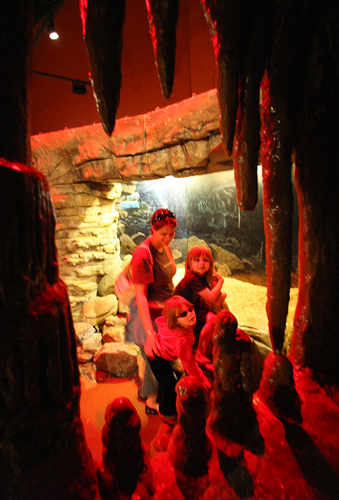‘In the Dark’ exhibit reveals how creatures survive, thrive in pitch-black conditions



Rat Parmesan, anyone?
Assuming your culinary tastes tend toward the, well, exotic, you’ve got to catch the creepy critter first. Just slip your hand inside that snake-decorated oven mitt and keep scanning the monitor with it — can you nail the ugly bugger streaking across the screen somewhere in utter blackness, just like a snake would? Even at a slow speed, it’s an elusive little dinner entree, isn’t it?
Settle for a peanut butter and jelly sandwich.
"We wanted an exhibit that had a lot of interactive, hands-on experiences for families but would also be of interest to adults and older children," says Aaron Micallef, curator at Springs Preserve, which is hosting the "In the Dark" exhibit at its New Frontier Gallery through May 15, examining how animals — including humans — adapt in the dark.
The traveling show comes courtesy of the Cincinnati Museum of Natural History.
"I come in to see how people are interacting with the exhibits. Some I thought would be more difficult for the kids, like the one on how snakes use heat to find prey because their sight isn’t good — but the kids immediately get right into it."
Yup. One just caught that rat. Great reflexes, kid.
Creepiest exhibit? That giant re-created bat head over there. Yeech. Go ahead. Shove your noggin inside the hollow opening in back. Then persuade someone to get in front of it and walk closer and closer. Hear that clicking sound? The one gaining speed as its prey draws near until it sounds like machine-gun fire? Gotcha!
"Bats do not have very good eyesight, but very large ears," Micallef says. "And the larger the ear, the better it is at finding sound."
Gaze around and the educational (and fun) pickings are extensive. "There’s a section on the deep sea and in the ocean most creatures live in complete darkness," Micallef explains. "They head toward the surface at night. They’re called vertical migrators. When dawn approaches, they head back down to the deep sea. There’s this whole ecosystem that covers the vast majority of this planet that we know nothing about."
Say, that exceptionally unattractive female angler fish, which uses its bioluminescent quality to attract a male that, Micallef notes, is essentially a parasite that attaches itself to her. "It slowly gets absorbed into her bloodstream until they’re just the gonads attached," he says. "It’s a joke among biologists: "THAT’s commitment."
Well, at least it eliminates all those complicated dating rituals.
Take in all the nocturnal sound effects — crickets chirping, cats meowing — while learning how birds fly at night to avoid predators, fixing their direction by the stars. Study drawings of people hiking in daylight and darkness and select which scene has more mammals around to keep you company. Catch the nighttime forest re-creation featuring a flying squirrel (sorry, no Bullwinkle). Roam a cave. Use a balance wheel to experience how a jellyfish orients itself with its fluid-filled pouches, called "statocycsts."
Guess what? You’re a star-nosed mole. Plop down at this exhibit and listen — is that sound it (you) hears a dog digging up dirt, a lawnmower, running water? Choose the answer on a touch-screen.
Or wander over to the section about the scourge of homeowners everywhere (other than the banks) — termites. Using a "robomite" on the screen, explore a nest of the pests and see how they build mud tunnels that connect their colonies underground to the wood on which they munch. That answers the question a sign poses: "How can they stay in the dark, moist soil and still make a meal of your house?" Frighteningly easy, apparently.
"There’s a lot of mental stimulation," says 21-year-old exhibit-goer Lisen Skyborg of Las Vegas, sampling nearly every interactive component. "Things I did not learn in school I’m learning now. I’m a kinetic learner. It’s more interesting versus going to a museum and looking at pictures and reading. Here you remember. It’s like: ‘I remember when I stuck my head inside of a bat’s head.’ "
Equally fascinated is 26-year-old Las Vegan Maria Marchian. "You really use your senses," she says. "You put yourself in their position and you can understand what an animal that doesn’t have any sight would go through, or what a blind person would go through."
Arriving at the human experience, the exhibit examines how, in addition to Braille, technology aids blind people, including a hand-held sensor that detects objects at varying distances. "I have a good friend who went blind in her 30s," Micallef says.
"She has been dealing completely with adaptive technologies. She had something that could scan something and speak it back to her. A lot of folks who are blind don’t use Braille because it’s getting to the point where technology is so helpful. But I think if you were blind when you were born, you still learn Braille."
Fish or bird, rat or squirrel, termite or human — life goes on when the lights go down.
Contact reporter Steve Bornfeld at sbornfeld@ reviewjournal.com or 702-383-0256.
Preview"In the Dark" exhibit
10 a.m.-6 p.m. daily (through May 15)
New Frontier Gallery at Springs Preserve, 333 S. Valley View Blvd.
General admission to all attractions: $4.95-$9.95 for Nevada residents; $10.95-$18.95 for nonresidents; free for all children under 5 (822-7700; www.springs preserve.org)













